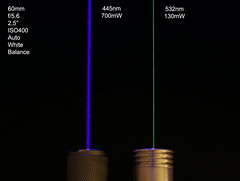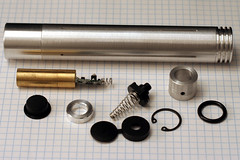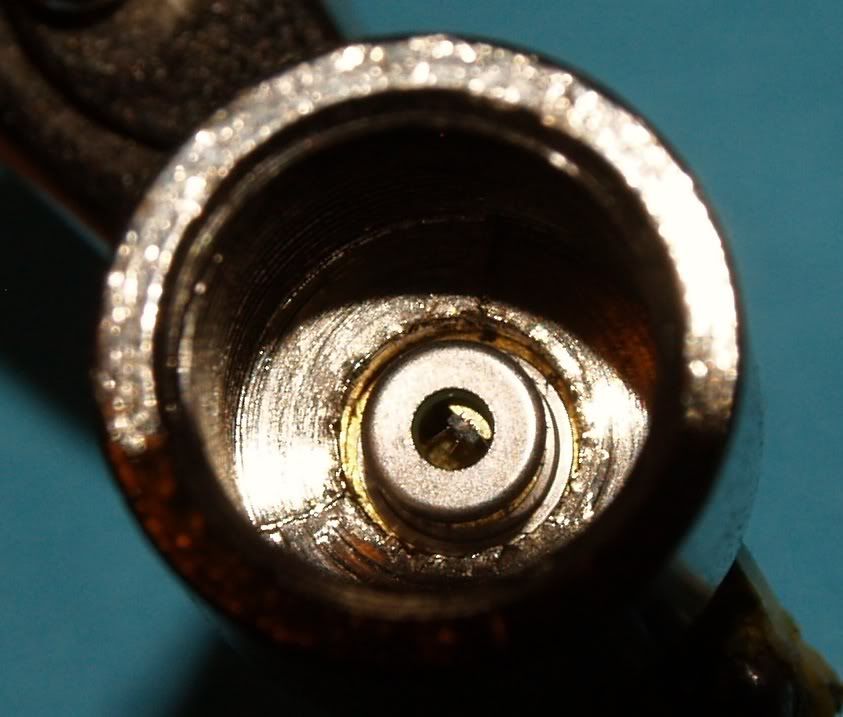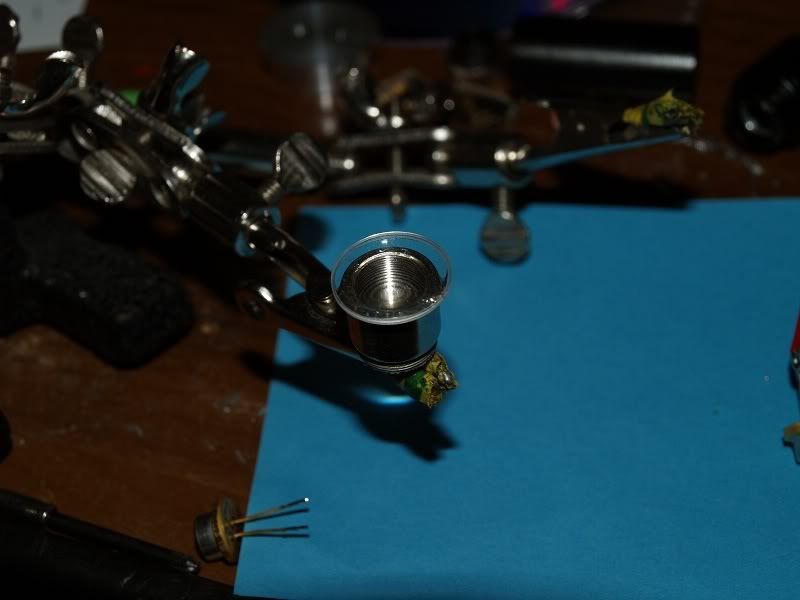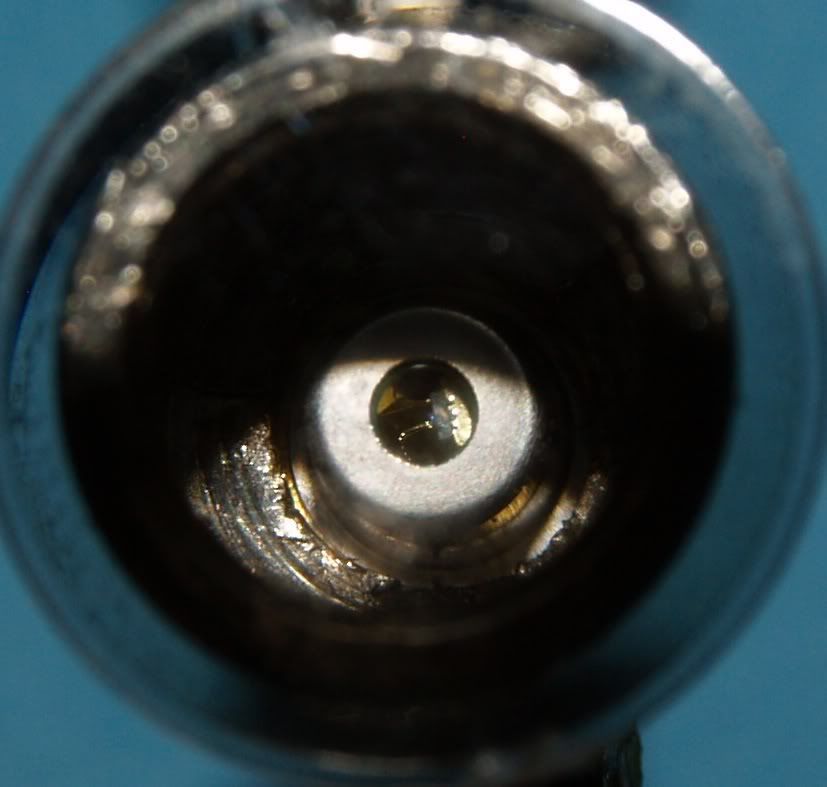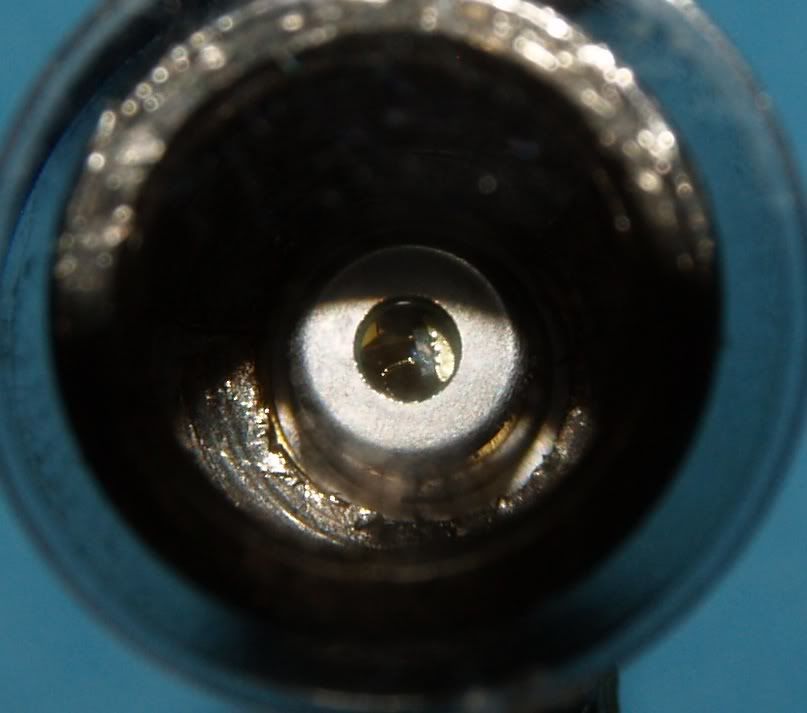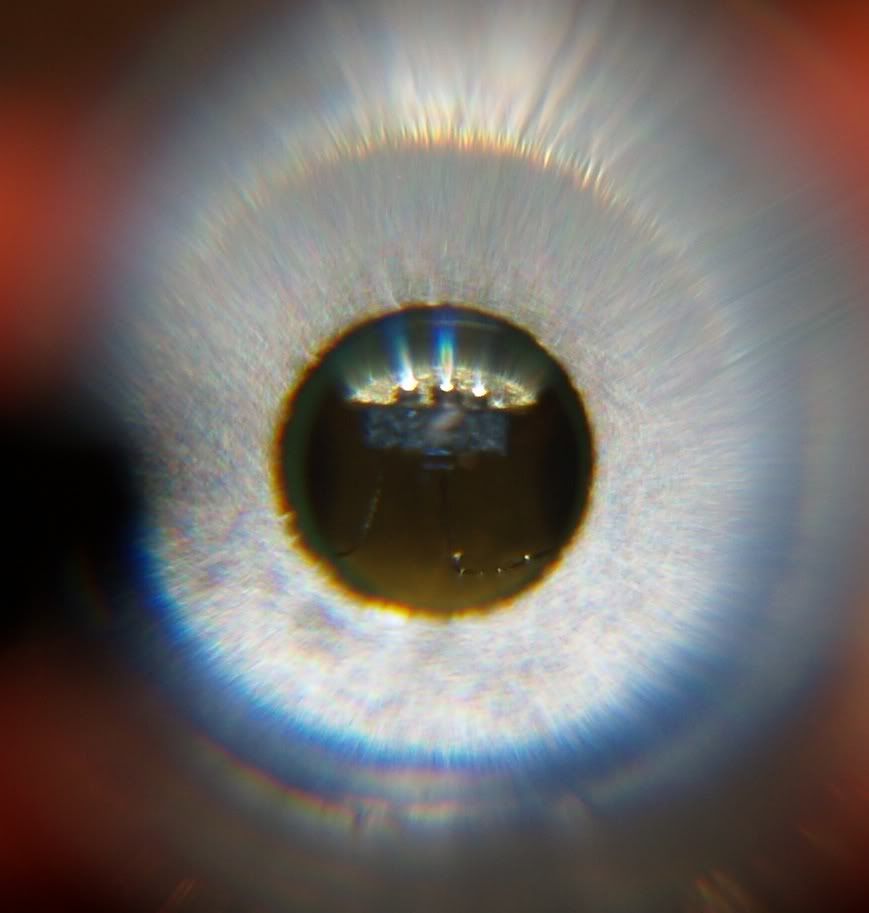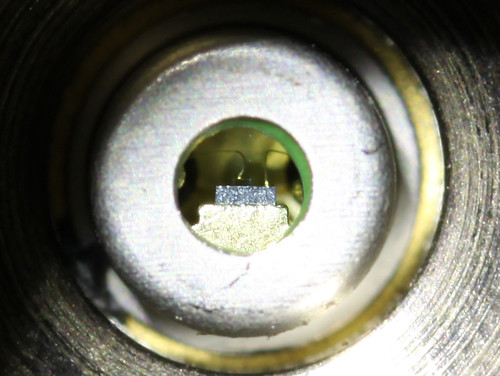- Joined
- Dec 21, 2008
- Messages
- 1,223
- Points
- 0
Preface
When I first joined LPF 18mths ago, I would never have imagined reaching 1,000 posts, but here I am, posting it... How fitting it should coincide with the latest of several major milestones in the field of hobby lasing, the 445nm diode! Not only do such technical milestones attribute to the excitement that has me browsing LPF on a daily basis, but also its diverse group of knowledgeable members that have come to be synonymous with LPF. Without them, I don’t think I would have managed to make it to 1000, regardless of the technology that brings us all together in this very global, yet somehow distinctly local meeting place that is LPF :beer:
How fitting it should coincide with the latest of several major milestones in the field of hobby lasing, the 445nm diode! Not only do such technical milestones attribute to the excitement that has me browsing LPF on a daily basis, but also its diverse group of knowledgeable members that have come to be synonymous with LPF. Without them, I don’t think I would have managed to make it to 1000, regardless of the technology that brings us all together in this very global, yet somehow distinctly local meeting place that is LPF :beer:
*Warning* I’m rather (in)famous for my well, let’s just say, detailed reviews; so no, I won’t hold it against you if you only look at the pretty pictures… (speaking of which, click on any image to view the full-res, 1280x963 version).
Ain't that a fine-lookin' host...

Intro
A 445nm diode, who would have imagined that, just six months ago, when the 8X BluRay diode was the hottest thing on the DIY block! While everyone had to give carefully consideration to their budgets before plunking down over $200 for a 12x BR optical drive, here comes a $45 diode our way, in a new and exciting wavelength rated at 1W no less… ! who here hasn’t dreamed of owning a 473nm blue DPSS laser? Who here isn’t familiar with Glenn’s enticing CNI group buys? Who here has, oh, $1000 to donate to the hobby? Clearly my point is to impress upon the fact that this 445nm 1W diode, harvested from Casio XJ-A1_0 projectors, is truly a milestone in our humble but exciting hobby :bowdown:
Hello, Mr. diode.

JayGuin and the beauty of the DIY Community
With everyone going mad over Wicked Laser’s 445nm laser, I had no second thoughts about going DIY. In the past, cost savings played a major role but not this time around. So why go local? I can answer that one in exactly two words: JayRob and Daguin… ! The following is a reenactment of what took place during the production of the JayGuin 445nm Razor Lazor:
Trav: “Hi Professor, what’s your take on this new fangled 445nm diode?”
DG: “It’s the new dawning of our hobby. We have been blessed by the Gods of DIY-lasing.”
Trav: “OMG – ah, let’s put my 12x project on hold – what kind of host do I need, Professor?”
DG: “18650. Talk to any one of LPFs Host/Kit providers*…”
Trav: “Jay, gotta love that 18650 kit of yours, but tbh, it doesn’t match my new grey Audi R8 spyder (j/k)… I did find a host that does, though…”
JR: “If the thing uses batteries, I can turn it into a host. Lemmie order one up for ya.”
…2 weeks go by…
JR: “I got your host today, nice!"
...a few hours go by...
JR: "I shipped your host today to the professor.”
Trav: “…how the f… does he do that…!”
…2 days go by…
DG: “I got the the host from Jay, but I’m a bit under the weather, I may need an extra day or two…”
Trav: *thinking of his recent IgorT project…* “But of course, Professor, take all the time you need!”
…3 days go by…
DG: “I shipped it at the values your specified, should be with you in a few days…”.
Trav: “…how the f… does he do that…!”
…9 days go by… (well, heck, I live in Austria)
*door-bell rings*
Trav: :drool:
*Such as Ehgemus, Flaminpyro, JayRob, Kenom, Likeitbright, Mohrenberg among other talented locals, all great and reliable designers of hosts and kits here at LPF!
I think you get the point. The real advantage of going with the DIY community is not to save money (not that I’m bitching about it ) but to have the opportunity to own something very unique, not to mention hand-made to very high quality standards. Of the dozen or so lasers I own, most are DIY models, all which still work to this day, all of which are truly amazing examples of what our members are capable of! :bowdown:
) but to have the opportunity to own something very unique, not to mention hand-made to very high quality standards. Of the dozen or so lasers I own, most are DIY models, all which still work to this day, all of which are truly amazing examples of what our members are capable of! :bowdown:
Pictured, 7 of my 11 DIY lasers (see my sig for detailed reviews and photos).
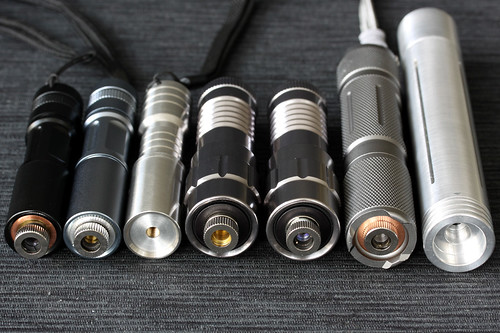
445 @ 666…
Let’s go over the basics real quick; the laser is based on a 445nm diode that was harvested from a Casio XJ-A140 projector. I doubt that either the wavelength or laser projectors are new to Science, but certainly new to the average consumer, not to mention to our DIY community. 445nm is an interesting wavelength as it falls somewhere between our “funny-looking” near-ultraviolet 405nm BluRay diodes and the currently only official “blue” laser on the market, a 473nm laser based on DPSS technology. As can be expected in a DIY environment, cost plays a major role and we went from $40 4X BR diodes to $200 12X BR diodes really quick. At $200, just for one diode which may or may not last the distance, DIY was getting a bit risky, financially-speaking. Along came Casio with its array of 24 diodes, allowing the DIY community to provide a single 445nm diode with a very reasonable sub-$50 price tag!
Ain't that a fine-lookin' host...

So what can this 445nm do? Well, it’s being touted as a 1W diode. I’m not sure if this is fact or assumption, based on educated guesses or own testing, but we have seen several members push the diode beyond 1W, so, the label is probably warranted. There is a problem however, of running a diode at 1W or more and that problem is heat. Even if you have an appropriate “micro” driver capable of delivering the necessary Amp or so of current needed, it is all but impossible to successfully cool this 1W diode in a “Laser Pointer” or similar host. Hence, most of the members running near-1W 445nm diodes are doing so with a “labby” style host, most of which are properly cooled with large heat sinks, not to mention active cooling (fans). Hence, although capable of much higher powers, the DIY community is opting for more modest OP values in the range of 500-800mW for portable builds. Having spoken to the Professor about it, I settled on 550mW after Aixiz glass.
Number of the (blue) beast :eg: after Jay’s 405-G-1 glass.

Even at these “lower” powers, cooling is still a top priority and a properly-integrated heat sink is a must. Although most DIYers have relied on and worked around an Aixiz module, the need for better cooling introduced the concept of the press-in Heat sink. This is where the diode is pressed directly into the back of the heatsink and the front is threaded to accommodate an Aixiz-style lens assembly. Several members have already been won over by this concept, including LikeitBright and of course, JayRob, who’s precision work is up for display here:
Now that's what I call a heat sinnk...

Good lord, It’s a Razor Lazor!
One unique property, not to mention, a highly debated topic of these 445nm diodes is the beam profile. Initially, we were discussing the profile in terms of non-Tem00 modes but I’m not quite sure if that is accurate. I’ve never seen such a profile discussed on the Net (friends, please feel free to enlighten me…) but it has now become known as “bar-shaped” here on LPF. And there’s a good reason for that nick, too. I don’t care what lens you use, be it one of the 405-G-1s available at LPF or be it Aixiz’s upcoming 400-450nm coated glass, the profile will still be… a bar.
Who needs a razor when you got a lazor blade...
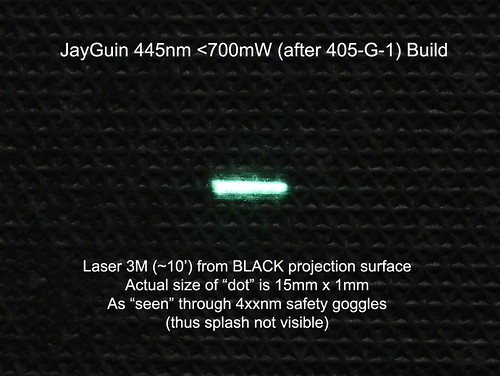
The above image was taken under very controlled conditions. What you are seeing is the beam projected onto a black, textured surface, properly focused and through safety goggles to eliminate “splash”. The reason the image is black and not the typical orange is because I manually controlled the white balance when I made the image. Now that we know what it looks like, what are we going to do with it? I mean, the beam has a divergence of roughly 4.5mrad, not too pretty, right. But of course divergence has its positive side, the beam will look phat in the (no-fly zone) night sky… .
To be honest you with, I wasn’t impressed with the profile and I even had myself wondering why I went for this diode. Fact: DPSS has better divergence and some of the 532nm portables on the market come close to the 445’s output levels. Fact: a 12x BR diode is the (DIY) way to go if you want to burn (and see it at the same time, otherwise you might as well turn to IR lasers), not to mention, fluoresce. But wait a minute, this odd-looking profile burns, and burns pretty well at close distances!?! At .5m or less, I guarantee you this thing will burn… thus my new nick for 445nm-diode lasers, the one and only Razor Lazor trav-tm
The total annihilation of an otherwise innocent CD jewel case…

How Bright is 445nm Blue?
In another thread, a few of the fellas engaged in a debate over how bright this wavelength – at these powers - really is. So we all grabbed our <200mW 532nm greenies along with our new 445s went out into the (no-fly zone) night sky and let our eyes decide… . “Green!” “No, blue!” “Now way, Jose, green!” And so forth. I personally thought that my 130mW green “looked” brighter than my 650mW 445… . The debate did remind me of Daguin’s excellent thread, Strange Things About Blu-Ray (405nm). The fact is, 445nm is not all that different from the venerable 405nm near-UV wavelength and thus, it’s quite reasonable to assume not everyone will see the same thing. I wear (1.5 diopter) prescription glasses and they are finished with AR and UV-blocking coatings (as most glasses are). At 3M range, I can see the projection clearly with and w/o my glasses but the visual difference is substantial, in terms of core shape as well as splash.
So I thought I’d let my camera decide. It too, will see something different from my eyes, even from other cameras. A digital camera’s sensor typically uses color filters in the classic “RGB” format. There are, however, exceptions to the rule, with filters in a “GRGB” or “RGGB” pattern. The theory being that the human eye likes green the best, so the sensors will highlight green. With this in mind, I took a few “realistic” shots, the aim being to compare brightness of several wavelengths and not to impress with over-exposed or amaze with smoky backgrounds. Despite my conviction that green was brighter, the camera chose blue…
White balance produced a purple hue but it is blue to the eye (see farther below
for a more “true to life” image). The point however was to show the difference
in intensity and the 445nm is clearly the brighter of the three depicted.
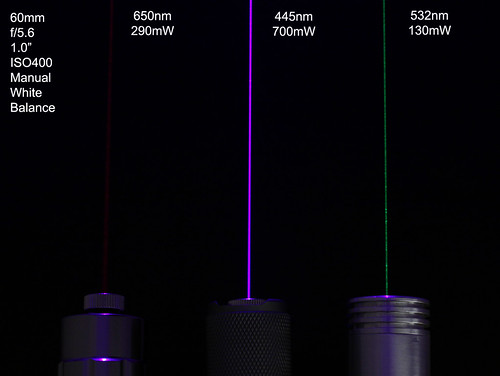
Well, I’m blown away…
In conclusion, I have to say I had my doubts about this diode and it’s rather odd bar-shaped profile. But after some testing and some simple enjoyment in the (no-fly zone) night sky, I have to admit that it has quickly become one of my favorite lasers! Not only am I enjoying this unique and novel diode, I’m also enjoying it in a very cool-looking host with some very cool gear (such as a Drlava’s Microboost driver) made by some very cool members. Fit and finish, form and function; all first-class, as can be expected from the likes of our JayRob and Daguin, both outstanding DIYers and major contributors at LPF. I cannot recommend the two highly enough and look forward to the next collaboration in the near future!
Cheers :beer:
Love this style of host…

…can you tell…

…?
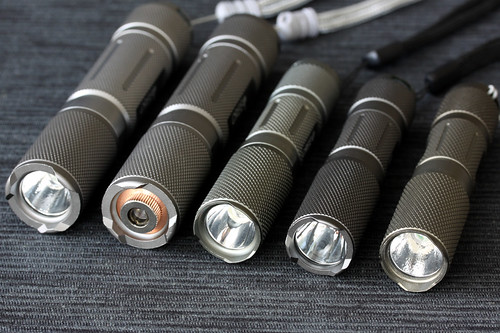
Jay‘s Cu press-in heat sink is exactly what this hot diode needs…
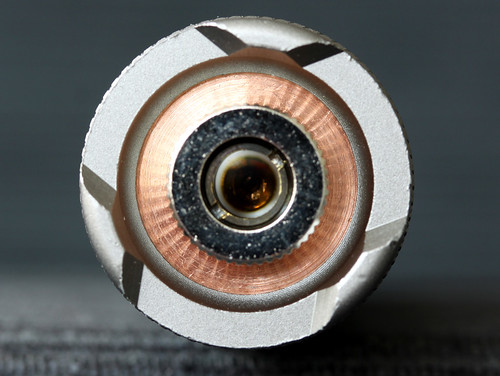
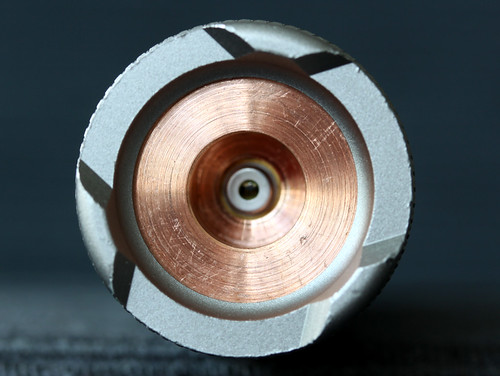

Never mind the lens, It’s a bar…
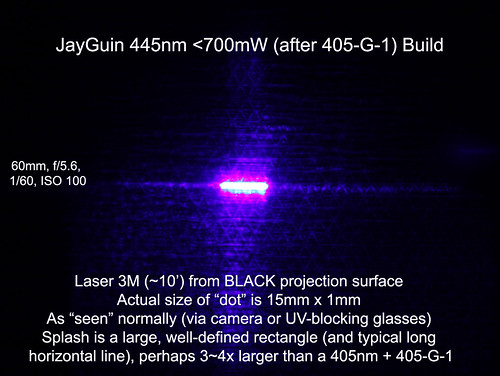
...with the classic splash of a long, intersecting line and a
rather uniform rectangle just below (above) it…
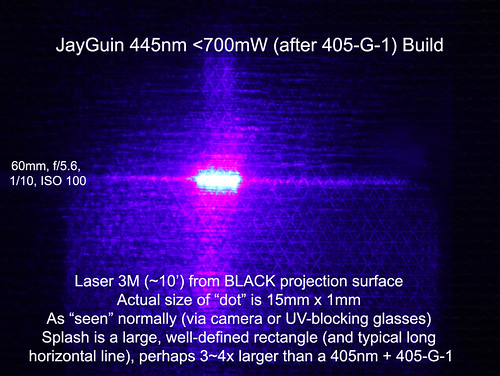
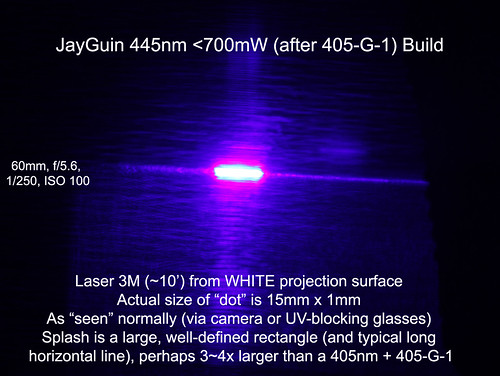
And a bar at the end of a very good-looking beam at that…
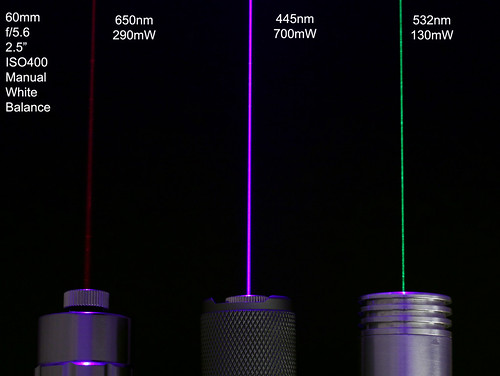
A blue beam, at least when my camera feels like cooperating with me ;p
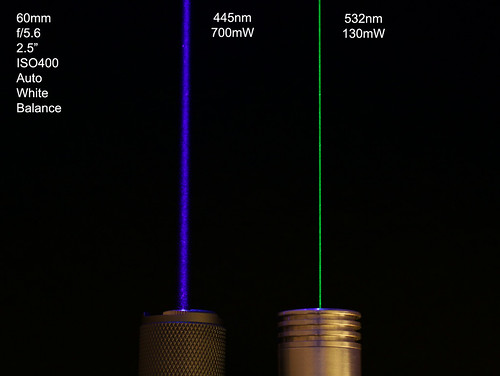
A blue beam that humbles my 230mW 6X in comparison…

When I first joined LPF 18mths ago, I would never have imagined reaching 1,000 posts, but here I am, posting it...
*Warning* I’m rather (in)famous for my well, let’s just say, detailed reviews; so no, I won’t hold it against you if you only look at the pretty pictures… (speaking of which, click on any image to view the full-res, 1280x963 version).
Ain't that a fine-lookin' host...

Intro
A 445nm diode, who would have imagined that, just six months ago, when the 8X BluRay diode was the hottest thing on the DIY block! While everyone had to give carefully consideration to their budgets before plunking down over $200 for a 12x BR optical drive, here comes a $45 diode our way, in a new and exciting wavelength rated at 1W no less… ! who here hasn’t dreamed of owning a 473nm blue DPSS laser? Who here isn’t familiar with Glenn’s enticing CNI group buys? Who here has, oh, $1000 to donate to the hobby? Clearly my point is to impress upon the fact that this 445nm 1W diode, harvested from Casio XJ-A1_0 projectors, is truly a milestone in our humble but exciting hobby :bowdown:
Hello, Mr. diode.

JayGuin and the beauty of the DIY Community
With everyone going mad over Wicked Laser’s 445nm laser, I had no second thoughts about going DIY. In the past, cost savings played a major role but not this time around. So why go local? I can answer that one in exactly two words: JayRob and Daguin… ! The following is a reenactment of what took place during the production of the JayGuin 445nm Razor Lazor:
Trav: “Hi Professor, what’s your take on this new fangled 445nm diode?”
DG: “It’s the new dawning of our hobby. We have been blessed by the Gods of DIY-lasing.”
Trav: “OMG – ah, let’s put my 12x project on hold – what kind of host do I need, Professor?”
DG: “18650. Talk to any one of LPFs Host/Kit providers*…”
Trav: “Jay, gotta love that 18650 kit of yours, but tbh, it doesn’t match my new grey Audi R8 spyder (j/k)… I did find a host that does, though…”
JR: “If the thing uses batteries, I can turn it into a host. Lemmie order one up for ya.”
…2 weeks go by…
JR: “I got your host today, nice!"
...a few hours go by...
JR: "I shipped your host today to the professor.”
Trav: “…how the f… does he do that…!”
…2 days go by…
DG: “I got the the host from Jay, but I’m a bit under the weather, I may need an extra day or two…”
Trav: *thinking of his recent IgorT project…* “But of course, Professor, take all the time you need!”
…3 days go by…
DG: “I shipped it at the values your specified, should be with you in a few days…”.
Trav: “…how the f… does he do that…!”
…9 days go by… (well, heck, I live in Austria)
*door-bell rings*
Trav: :drool:
*Such as Ehgemus, Flaminpyro, JayRob, Kenom, Likeitbright, Mohrenberg among other talented locals, all great and reliable designers of hosts and kits here at LPF!
I think you get the point. The real advantage of going with the DIY community is not to save money (not that I’m bitching about it
Pictured, 7 of my 11 DIY lasers (see my sig for detailed reviews and photos).

445 @ 666…
Let’s go over the basics real quick; the laser is based on a 445nm diode that was harvested from a Casio XJ-A140 projector. I doubt that either the wavelength or laser projectors are new to Science, but certainly new to the average consumer, not to mention to our DIY community. 445nm is an interesting wavelength as it falls somewhere between our “funny-looking” near-ultraviolet 405nm BluRay diodes and the currently only official “blue” laser on the market, a 473nm laser based on DPSS technology. As can be expected in a DIY environment, cost plays a major role and we went from $40 4X BR diodes to $200 12X BR diodes really quick. At $200, just for one diode which may or may not last the distance, DIY was getting a bit risky, financially-speaking. Along came Casio with its array of 24 diodes, allowing the DIY community to provide a single 445nm diode with a very reasonable sub-$50 price tag!
Ain't that a fine-lookin' host...

So what can this 445nm do? Well, it’s being touted as a 1W diode. I’m not sure if this is fact or assumption, based on educated guesses or own testing, but we have seen several members push the diode beyond 1W, so, the label is probably warranted. There is a problem however, of running a diode at 1W or more and that problem is heat. Even if you have an appropriate “micro” driver capable of delivering the necessary Amp or so of current needed, it is all but impossible to successfully cool this 1W diode in a “Laser Pointer” or similar host. Hence, most of the members running near-1W 445nm diodes are doing so with a “labby” style host, most of which are properly cooled with large heat sinks, not to mention active cooling (fans). Hence, although capable of much higher powers, the DIY community is opting for more modest OP values in the range of 500-800mW for portable builds. Having spoken to the Professor about it, I settled on 550mW after Aixiz glass.
Number of the (blue) beast :eg: after Jay’s 405-G-1 glass.

Even at these “lower” powers, cooling is still a top priority and a properly-integrated heat sink is a must. Although most DIYers have relied on and worked around an Aixiz module, the need for better cooling introduced the concept of the press-in Heat sink. This is where the diode is pressed directly into the back of the heatsink and the front is threaded to accommodate an Aixiz-style lens assembly. Several members have already been won over by this concept, including LikeitBright and of course, JayRob, who’s precision work is up for display here:
Now that's what I call a heat sinnk...

Good lord, It’s a Razor Lazor!
One unique property, not to mention, a highly debated topic of these 445nm diodes is the beam profile. Initially, we were discussing the profile in terms of non-Tem00 modes but I’m not quite sure if that is accurate. I’ve never seen such a profile discussed on the Net (friends, please feel free to enlighten me…) but it has now become known as “bar-shaped” here on LPF. And there’s a good reason for that nick, too. I don’t care what lens you use, be it one of the 405-G-1s available at LPF or be it Aixiz’s upcoming 400-450nm coated glass, the profile will still be… a bar.
Who needs a razor when you got a lazor blade...

The above image was taken under very controlled conditions. What you are seeing is the beam projected onto a black, textured surface, properly focused and through safety goggles to eliminate “splash”. The reason the image is black and not the typical orange is because I manually controlled the white balance when I made the image. Now that we know what it looks like, what are we going to do with it? I mean, the beam has a divergence of roughly 4.5mrad, not too pretty, right. But of course divergence has its positive side, the beam will look phat in the (no-fly zone) night sky… .
To be honest you with, I wasn’t impressed with the profile and I even had myself wondering why I went for this diode. Fact: DPSS has better divergence and some of the 532nm portables on the market come close to the 445’s output levels. Fact: a 12x BR diode is the (DIY) way to go if you want to burn (and see it at the same time, otherwise you might as well turn to IR lasers), not to mention, fluoresce. But wait a minute, this odd-looking profile burns, and burns pretty well at close distances!?! At .5m or less, I guarantee you this thing will burn… thus my new nick for 445nm-diode lasers, the one and only Razor Lazor trav-tm
The total annihilation of an otherwise innocent CD jewel case…

How Bright is 445nm Blue?
In another thread, a few of the fellas engaged in a debate over how bright this wavelength – at these powers - really is. So we all grabbed our <200mW 532nm greenies along with our new 445s went out into the (no-fly zone) night sky and let our eyes decide… . “Green!” “No, blue!” “Now way, Jose, green!” And so forth. I personally thought that my 130mW green “looked” brighter than my 650mW 445… . The debate did remind me of Daguin’s excellent thread, Strange Things About Blu-Ray (405nm). The fact is, 445nm is not all that different from the venerable 405nm near-UV wavelength and thus, it’s quite reasonable to assume not everyone will see the same thing. I wear (1.5 diopter) prescription glasses and they are finished with AR and UV-blocking coatings (as most glasses are). At 3M range, I can see the projection clearly with and w/o my glasses but the visual difference is substantial, in terms of core shape as well as splash.
So I thought I’d let my camera decide. It too, will see something different from my eyes, even from other cameras. A digital camera’s sensor typically uses color filters in the classic “RGB” format. There are, however, exceptions to the rule, with filters in a “GRGB” or “RGGB” pattern. The theory being that the human eye likes green the best, so the sensors will highlight green. With this in mind, I took a few “realistic” shots, the aim being to compare brightness of several wavelengths and not to impress with over-exposed or amaze with smoky backgrounds. Despite my conviction that green was brighter, the camera chose blue…
White balance produced a purple hue but it is blue to the eye (see farther below
for a more “true to life” image). The point however was to show the difference
in intensity and the 445nm is clearly the brighter of the three depicted.

Well, I’m blown away…
In conclusion, I have to say I had my doubts about this diode and it’s rather odd bar-shaped profile. But after some testing and some simple enjoyment in the (no-fly zone) night sky, I have to admit that it has quickly become one of my favorite lasers! Not only am I enjoying this unique and novel diode, I’m also enjoying it in a very cool-looking host with some very cool gear (such as a Drlava’s Microboost driver) made by some very cool members. Fit and finish, form and function; all first-class, as can be expected from the likes of our JayRob and Daguin, both outstanding DIYers and major contributors at LPF. I cannot recommend the two highly enough and look forward to the next collaboration in the near future!
Cheers :beer:
Love this style of host…

…can you tell…

…?

Jay‘s Cu press-in heat sink is exactly what this hot diode needs…



Never mind the lens, It’s a bar…

...with the classic splash of a long, intersecting line and a
rather uniform rectangle just below (above) it…


And a bar at the end of a very good-looking beam at that…

A blue beam, at least when my camera feels like cooperating with me ;p

A blue beam that humbles my 230mW 6X in comparison…





